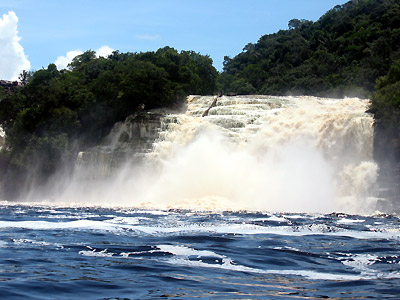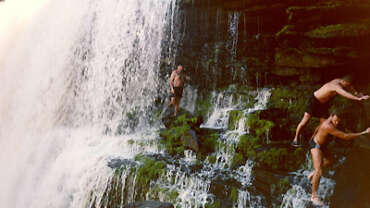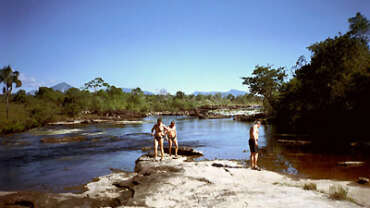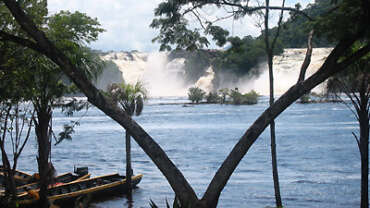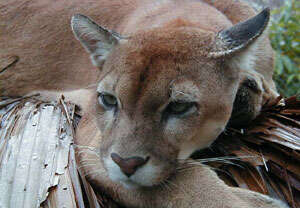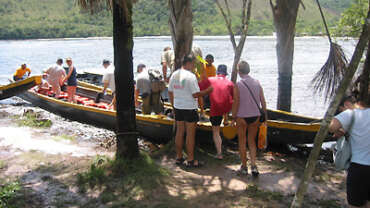Margarita Island
Stretching 32km north to south and 67km east to west, Isla Margarita covers an area of 920km² and is Venezuela’s largest Caribbean island. According to legend, Margarita was created by the teardrop of a cherub and named the “Pearl of the Caribbean”. In reality, however, it formed when a narrow sand bar emerged from the sea and connected two adjacent islands. The sand bar and its surroundings, which comprise mangroves, salt-flats and a lagoon, are now the Laguna de la Restinga National Park.
Getting to Margarita is very easy. The island has a large international airport, (Santiago Mariño) and receives flights from Europe, North America and Canada. A dozen daily flights operate between Margarita and Caracas, as well as several daily flights to and from most other cities in Venezuela, including Puerto Ordaz, Maracaibo, Barcelona, Maturín, Tucupita, Valencia and San Antonio. Fares are relatively reasonable. The ferry is perhaps the most popular means of transport, as it enables visitors to bring their cars. The ferry terminal is called Punta de Piedras and there are several daily crossings between Margarita and Puerto la Cruz, Cumana and Trinidad. Ferries can be express or regular, and take passengers, vehicles or both.
Throughout the year, the east side of Isla Margarita maintains an average temperature of 25ºC to 28ºC, and enjoys a cooling breeze. The peninsula is less windy, and temperatures soar. The rainy season lasts from November to January, but as rain tends to fall during the night, most days remain dry.
Margarita
The Macanao Peninsula forms the western side of Margarita, and is characterized by its distinctive red earth, cactus-covered coastline and mangrove swamps of the lagoon. The land is dry, barren and infertile, and much of the territory is desolate scrub; yet the striking colors lend the peninsula a rare and peculiar beauty. Just 15,000 people inhabit the region; most of whom live in small fishing villages scattered along the coast. The inland area remains undeveloped, home to just wild deer, goats and hares that browse the sparse vegetation on the hills.
The life and landscape of the region contrast greatly with that of its eastern counterpart. Home to some 300,000 citizens, the east side of Margarita has rich soil, cool valleys and lively, busy towns. The capital of the state, La Asunción, was so chosen for the sole reason that its inland location would shield it from pirate attacks. With a population of around 17,000, it is a quiet, cultural town with a tranquil plaza, cathedral, museums and the ancient hill fort of Santa Rosa. Porlamar, once a quiet, fishing village, has expanded in the last 15 years and is now the largest, busiest town on the island with a population of over 80,000.
Playa Paraguachí, El Tirano
In the Guaquerí language the island of Margarita was known as Paraguachoa: “abundance of fish”. Paraguachí signifies “abundance of lobster”.
The village Paraguachí lies in one of the freshest and most fertile valleys of the island. In the village square the trees create a shaded area where the 16th century church of San José can be seen. However, of the original structure only the sacrosant remains.
The 2lst of July 1561 saw the arrival at the Port of Paraguachí a spanish conquistador who would be remembered for his cruelty and bloodthirstiness: Lope de Aguirre. In his 40 days stay in the island he wiped out as many people as he could. Included in the massacre was the then governor Juan Sarmiento de Villandrando and many of his followers. Even members of his own crew were not spared his wrath. Leaving the island he left behind a trail of death and destruction. Months later he was caught by García de Pacides and his final act before surrendering was to stab his own daughter Elvira to death. Since then the port of Paraguachí (also called Fermín Port) has been called “EL TIRANO” (The Tyrant). Today as yesterday, El Tirano is a fishing village where it is possible to take boat rides to the islands of Los Frailes (the Friars lslands) about 45 minutes away.
In the Town Hall of Paraguachí can be found a statue of El Tirano made in Genoa, Italy. It came to the island in 1956 and was shown in the Nueva Cadíz museum in La Asunción. In 1994 it was moved to its present site.
Playa Parguito
This is one of the favorite beaches of the surfer. “Pegue” “Flote” “aéreo”(air) “360”(full circle) etc. are some of the words heard in Parguito; along with others like “glass”(self explanatory), “choppy”(likewise) and “picado”(real choppy) which describes the state of the sea.
Parguito is a ‘live’ beach: wide beach with calm water; medium beach with rolling waves; high water (season of hurricanes, which in Margarita -thank whatever- are tropical storms) and the waves can be “choppy” etc.
A good walk starts at the right hand side of the beach, by climbing the hill and following the path. You are leaving Parguito and going towards “Puerto Abajo”. Along this walk can be found a series of caves known only by the more adventurous (and caution is advised). One of them is called “The Witches Cave”, so called since the Colonial times, because a witch hid there from the Conquistadores and their faith. The story ends with the witch changing into a fish, strange and black. Many people have said they have seen its shadow in the water.
Playa Manzanillo
In the north of the island is Manzanillo beach known for its calm water and sunsets. Historians tell how the Guaiquerí were so friendly with Christopher Columbus so the spanish crown recognized their territorial rights and honored them with titles. It was here ships arrived to take on “Magnesita” coming by train (the only one on the island) from the mine in Loma de Guerra.
In the mornings one can see the collection of nets by the local community. Anyone can help and the normal reward is some of the fish you help to pull out.
Beware, the tree Manzanillo has a fruit which looks very attractive and tempting. Under no circumstances try it as it is extremely toxic.
Playa El Agua
The “In Place” for national and international tourists. The Water: (El Agua) 3 kms long. Water, beach, restaurants and a lot more. Its name came from the number of ponds and wells which over time have faded away. Here you can find everything to have a good time. There is no village of “El Agua”, but there is a organized community which has been and is concerned about the area.
Playa El Agua has an international community, German, French, Italian etc. which has added its flavour. It is perhaps the most visited area on the island, the most known and the most popular. It’s a small world within a world. In Playa El Agua and its outskirts (from Paraguachi to Manzanillo) you can find everything necessary, and the superflous as well without the need to travel much.
Be careful while in the water. Keep close to the shore since there is undertow and you may find yourself dragged out. If this happens, let yourself float a bit and try to get out from the side. Don’t fight against the current because tiredness may overcome you.
Coche and Cubagua
Near Margarita sit the sparsely inhabited islands of Coche and Cubagua, both of which have fairly good snorkeling and diving waters. Isla Coche can be visited by ferry from Punta de Piedras (the main ferry terminal), or by boat charter from La Isleta or El Yaque. It also has an airstrip. Isla Cubagua can be reached by boat from El Guamache.
These islands were originally inhabited by the Guaiqueiri Indians, and were discovered by Christopher Columbus in 1498. One year later, vast beds of pearls were found in the waters surrounding Cubagua. Settlers arrived in 1501 and established the first Spanish colony in South America: Nueva Cádiz. Margarita was colonised in 1525, and its first settlement, Pampatar, was founded in the 1530s. Once Cubagua’s supply of pearls had been depleted, the city was abandoned and later destroyed by two tidal waves, leaving just the ruins visible today. The three islands of Coche, Cubagua and Margarita comprise the state of Nueva Esparta (New Sparta). This name, reminiscent of the heroic Spartans of ancient Greece, was given as a tribute to the courage displayed by the Islanders during the Wars of Independence.
Tourism
Numbers of visitors to Margarita have soared since the fall of the Bolívar against the dollar in the early 1980s. The island is now the primary destination for the country’s holidaymakers, who come from the mainland in their thousands in search of sun, sand, surf and duty-free shopping. Foreign tourism, too is on the increase. The island’s foreign tourist industry was originally centered around Porlamar, a resort famous for its towering hotels, lively boulevards and thumping nightlife. Today, however, with the continuing influx of foreign visitors, large resorts have also expanded in the northeast. The busy, popular town of Playa el Agua is a good example.
Owing to such rapid and considerable growth, package tours are becoming increasingly common. During the August and September vacation period, many rooms are reserved by travel agencies, and those trying to find accommodation independently may experience difficulties. The latest development in the tourism industry is the all-inclusive deal, used mostly by foreign travel agencies.
The island certainly caters well for its tourists. Over 50 beaches and coves lie along the 167km of coastline, ranging from busy tourist hot spots to quiet fishing villages. There are plenty of restaurants, bars, shops and cafes. Many activities are on offer, including parascending, micro-lite flying, climbing and a variety of watersports. Snorkeling and scuba diving are very popular, and the best spots are around the rocky islands of Los Frailes, just off the coast of Playa el Agua. Los Frailes can be reached by boat charter from the towns of Juan Griego and El Tirano. Margarita is world-famous for windsurfing, and the beach of El Yaque on the southern coast is the best venue for this sport. Visitors can rent cars to tour the island or scooters to buzz from beach to beach. Vehicle hire is cheap, and the road network is good, with an extensive highway connecting the two sides of the island. Tours can be taken from Margarita to Los Roques, the Orinoco Delta and the Caribbean Islands.
The People
Most Margariteños have a mixture of Caribe and Spanish ancestry. The majority works either in the fishing or tourist industry, to cater for the island’s ever growing population of Venezuelan holidaymakers and foreign tourists. Local craftsmen and women make their living from artesanía such as baskets, ceramics, dolls and hammocks, which are sold as souvenirs to visitors in craft shops and stalls.
National Parks of Margarita
Margarita has two national parks: Cerro El Copey and Laguna de la Restinga, and three natural monuments (small parks): Cerro Matasiete y Guayamurí, La Laguna de las Marites, and Las Tetas de María Guevara (María Guevara’s breasts!). All protect a range of habitats and are home to various species of wildlife. Birds such as flamingoes, pelicans and scarlet ibis are most prolific in and around the mangrove swamps of La Laguna de la Restinga. The park has an area of 10,700ha and can be reached easily by road. Visitors can hire boats from the jetty to cruise the mangroves. Cerro El Copey covers an area of 7,130ha, and comprises both flat land with small villages and woodland-covered mountains, the latter of which offer fantastic views of the island. The park is located in the central eastern part of the main island and can be reached by road from La Asunción.



